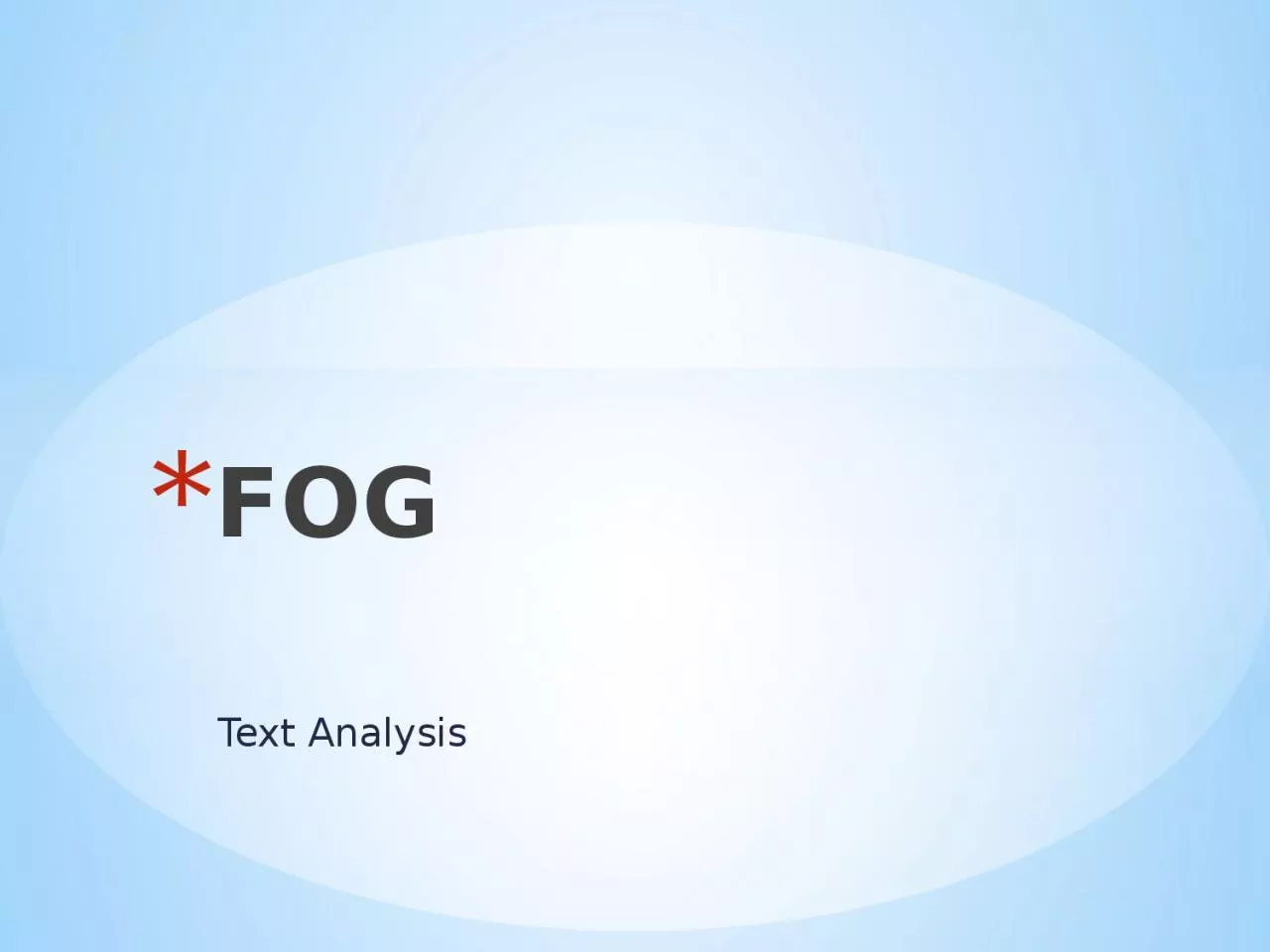

Equivalent syntagmatic syntactic position of fog in lines 111 whereas there is a change in position in lines 1214 Verbless All simple sentences ID: 1022430
Download Presentation The PPT/PDF document "Text Analysis FOG Position" is the property of its rightful owner. Permission is granted to download and print the materials on this web site for personal, non-commercial use only, and to display it on your personal computer provided you do not modify the materials and that you retain all copyright notices contained in the materials. By downloading content from our website, you accept the terms of this agreement.
1. Text AnalysisFOG
2. Position Equivalent syntagmatic/syntactic position of fog in lines 1-11 whereas there is a change in position in lines 12-14.
3. Verbless All simple sentences are verbless, while all complex sentences have verbless main clauses, consequently a predominantly nominal style.
4. EquivalenceLines 1-4. There is a short verbless simplesentence introducing two successive,syntactically equivalent complex sentences.Note the semantic opposition of theprepositional phrases in the principal clauses (upthe river/down the river), the same number ofsyllables in the main clauses and the equivalentphonetic/syntacvtic opening of the two subordinateClauses (where it flows/where it rolls).
5. Equivalence 2Lines 4-5: An exactly-balanced, verbless compound, both parts introduced by the subject fog, zero verb, and equivalent prepositional phrases of place.Note the semantic equivalence of Essex marshes/Kentish heights and consider whether the positionally equivalent (f) phonemes in marshes and Kentish are casual or non-casual.
6. Syntactic equivalenceLines 5-7: A sentence divided into three by the use of semi-colons, the first and third parts being simple sentences offset by a longer compound in the middle. Each sentence consists of the subject fog followed by equivalent predicate structures of zero auxiliary, present participle and prepositional phrase.
7. Lexical equivalenceThe series of prepositional phrases, apart from their syntactic/positional equivalence, are also the environment for a series of lexical equivalences in that cabooses of collier brigs, yards, rigging of great ships and gunwales of barges and small boats are all taken from the same semantic domain (shipping).
8. Phonetic equivalenceAgain phonetic equivalence is evident due to the equivalent syntactic structures used, particularly the nasals but also the number of /s/ fricatives which may just be casual usage determined by the syntactic choice of plural substantives or it may be a non-casual usage which would connect up with the use of (f) fricatives in the previous sentence.
9. SentencesLines 8-12. Once again, a long sentence divided into three parts by means of semi-colons. This time, however, the first two parts are equivalent complex sentences followed by a simple sentence.
10. VerblessAgain, the main clauses are all verbless whiloe the two subordinates have zero for the relaive pronoun and verb: wheezing = ‘who are wheezing’, down = ‘who is down’.
11. Syntactic/semantic equivalenceNote also the exact syntactic/semantic/positional equivalence of the first two main clauses (subject + zero verb + preposition + noun + noun + preposition + qualifier + noun) in which the first nouns in all three sentences are component parts of the third noun, which is itself each time semantically equivalent, with age and years of service being the only distinctive components.
12. Change of subjectLines 12-15. Note sudden change of subject. Fog is no longer highlighted in the subject position in the syntagm but rather the noun phrase chance people. Consider also the relevance of the phonological equivalence established by the plosives in people on the bridges peeping over the parapets.
13. NetherCheck in the dictionary the word nether and contrast its denotative meaning with its connotations that are to be found in contexts like nether worlds or nether regions.Note again the shift from places Fog everywhere to people fog all around them.
14. AnalogyFinally, consider the analogy between the people in the city covered in fog and people in a balloon in the clouds. Note the metaphorical nether sky of fog and the simile introduced by as if.
15. MetaphorCompare the last metaphors with the simple metaphors of lines 5-7, fog creeping, fog hovering and fog drooping, as well as the figurative use of the verb to pinch in line 11.
16. CommentThe use of Fog creates the atmosphere and reflects its all-pervading presence.There is a progression from everywhere, going from the countryside to the dirty city and then specifically to the decks, and then the shift to people with fog all around them. (like a zoom lens)